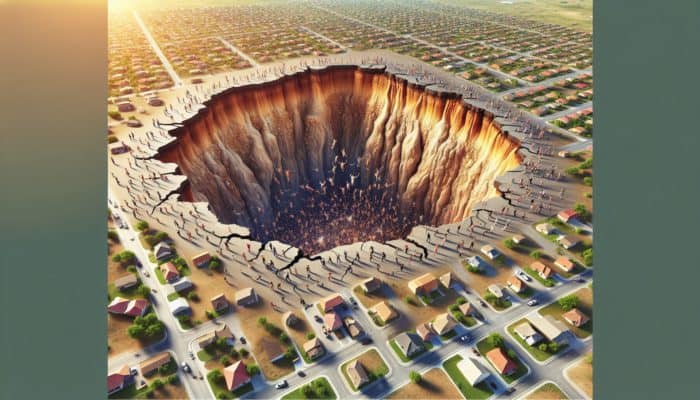Comprehending the Complex Nature of Sinkholes
Surviving a Sinkhole: Sinkholes represent both an intriguing and alarming natural phenomenon that can appear abruptly, leading to substantial disruption in affected areas. The formation of sinkholes involves a complex interplay of various geological conditions, environmental factors, and human activities. Understanding these intricate details is crucial for individuals seeking to enhance their preparedness for surviving a sinkhole incident. Knowledge and awareness are crucial components in the first steps towards effective mitigation and ensuring safety during such events.
Identifying the Key Factors Behind Sinkhole Formation

At the heart of sinkhole development is the gradual erosion of soluble bedrock, which may comprise materials such as limestone, gypsum, or salt. When rainwater, often intensified by heavy rainfall or underground streams, seeps into these rocks, it slowly dissolves them over time, forming voids in the ground. This natural process can be further accelerated by human activities, including excessive groundwater extraction, construction projects, and changes in land use, all of which can disrupt the natural flow of water and intensify the erosion process.
In regions characterised by karst topography, where sinkholes are particularly common, the risk of formation escalates due to the inherent susceptibility of the landscape to develop underground cavities. The interaction between water and rock is pivotal; as groundwater levels fluctuate due to seasonal changes or human influence, the stability of the ground may be compromised. Gaining a thorough understanding of these causative factors empowers residents of sinkhole-prone areas to take appropriate measures, significantly improving their odds of surviving a sinkhole event.
Moreover, the implications of climate change are compounding these risks by altering rainfall patterns and intensifying storms. Regions that were previously deemed safe may now encounter sudden, unexpected sinkholes due to heightened moisture levels and increased flooding. Consequently, acquiring knowledge about the geological characteristics of your home and its environment is indispensable for effective risk management and preparedness strategies.
Exploring the Various Types of Sinkholes
The categorisation of sinkholes into three primary types—dissolution, cover-collapse, and cover-subsidence—underscores the diverse mechanisms that contribute to their formation and impact.
Dissolution sinkholes arise when rainwater, enriched with carbonic acid derived from atmospheric CO2, gradually erodes the underlying bedrock. These sinkholes often manifest as depressions or small ponds on the surface and can develop into more significant issues over time if left unaddressed. Conversely, cover-collapse sinkholes occur when the weight of the material covering the void becomes excessively heavy, resulting in a sudden collapse into the cavity below. This abrupt event poses immediate dangers to life and property, as it frequently occurs without warning.
Cover-subsidence sinkholes develop at a more gradual pace, characterised by the slow settling of the ground above a void. This type may present itself as a subtle depression rather than a sudden drop, providing individuals with more time to react appropriately. Understanding these classifications equips people with critical knowledge regarding potential risks, enabling them to devise better preparedness and response strategies for surviving a sinkhole incident.
Real-world occurrences of sinkholes can be observed across various locations worldwide, ranging from the notorious sinkhole incidents in Florida to the remarkable cenotes found in Mexico. Analysing these events offers invaluable insights into the types of sinkholes that may affect different regions, enriching our global understanding of this geological phenomenon and highlighting the need for ongoing research and awareness.
Spotting the Early Indicators of Sinkhole Activity
Recognising the early signs of sinkhole activity is crucial for mitigating damage and ensuring safety. Homeowners should remain vigilant for specific indicators, such as ground depressions that may range from subtle dips to more pronounced hollows. Structural issues, such as cracks in walls or ceilings, are also significant warning signs that may indicate potential sinkhole activity. These cracks may appear as vertical or horizontal fissures, signalling instability in the ground beneath.
Another notable sign is the sudden emergence of ponds or unusually muddy patches in the landscape. When the ground collapses, it can create a depression that collects water, resulting in standing water in areas where it didn’t previously exist. Monitoring these changes in the local environment is essential, particularly in regions with a documented history of sinkhole formations.
Awareness of these indicators not only supports individual safety but also prepares communities for collective action. Establishing a community watch programme can enhance the early recognition of sinkhole symptoms, fostering a proactive culture among residents. Sharing knowledge and observations can lead to quicker responses, ultimately strengthening efforts to survive a sinkhole scenario.
In addition to visual signs, residents should remain attentive to fluctuations in groundwater levels, as these changes can signal the imminent formation of a sinkhole. Regular assessments and diligent data collection can enhance understanding and inform effective response strategies, ensuring that communities are well-prepared for any eventualities.
Strategising for Sinkhole Risk Preparedness

Preparing for the risks associated with sinkholes is vital for protecting both lives and property. A proactive approach can substantially reduce the impact of a sinkhole incident, thereby enhancing the likelihood of successfully surviving a sinkhole event.
Conducting a Comprehensive Property Assessment
Start by undertaking a thorough assessment of your property, focusing on its geological stability and the characteristics of the surrounding landscape. Collaborate with local geological surveys or enlist the assistance of professionals to evaluate soil composition and groundwater levels. This information is crucial in determining whether your property is at risk, especially if it is situated in areas known for their susceptibility to sinkhole activity.
Regular inspections should encompass not just the exterior of buildings but also the surrounding environment. Be on the lookout for any alterations in ground elevation, cracks in pavements or walls, and shifting soil. Understanding the geological conditions in your vicinity is of utmost importance; certain regions, particularly those with karst landscapes, may exhibit a higher propensity for sinkhole development.
In addition to personal inspections, community resources can help assess broader environmental factors. Collaborating with local agencies can provide insights into regional sinkhole trends and potential threats, keeping you informed about the risks that may affect your area. This knowledge empowers you to make well-informed decisions regarding property enhancements or preventive measures, ultimately fortifying your defences against a sinkhole.
Moreover, integrating technology into your property assessments can provide real-time data and further enhance your preparedness. Utilise apps or devices that monitor ground stability or assess water levels in nearby wells. This proactive stance can be invaluable in surviving a sinkhole incident, ensuring that you are ready for any developments that may arise.
Essential Items for Your Emergency Kit
Effective preparation extends beyond property assessments; having a well-stocked emergency kit is crucial for a swift and effective response during a crisis. Start with the essentials: ensure that you have an adequate supply of water and non-perishable food items to sustain yourself and your family for several days in the event of an emergency. Include a robust first aid kit stocked with necessary medical supplies, ensuring you are equipped to manage minor injuries or health concerns.
Communication devices are paramount. Ensure that you have fully charged mobile phones or alternative communication methods, such as a battery-operated radio, to stay updated on local emergencies and developments. Additionally, prepare an emergency contact list that includes local authorities, family members, and friends who can assist during times of crisis.
Consider including items specific to your family’s needs, such as medications, hygiene products, and important documents like insurance papers. By personalising your kit, you enhance your readiness for various scenarios, ensuring that you are equipped not just for a sinkhole but for any emergency that may arise.
Regularly review and replenish your emergency kit to ensure that food and water supplies are fresh and that any expired items are promptly replaced. This practice not only prepares you for potential sinkhole incidents but also cultivates a general culture of preparedness within your household, equipping everyone to handle various emergencies effectively.
Understanding Insurance and Legal Implications

Navigating insurance coverage related to sinkhole damage is a vital aspect of preparedness. Begin by thoroughly reviewing your policy to understand its terms and conditions. It is essential to note that not all homeowners’ insurance policies cover repairs related to sinkhole damage; therefore, ensure that you have the appropriate coverage in place. Consult with your insurance agent to clarify what is included in your policy and what additional coverage may be necessary for sinkhole protection.
Familiarise yourself with local laws and regulations that pertain to sinkholes. Some jurisdictions impose specific guidelines on property owners in areas prone to sinkholes, including mandatory disclosures and regulations regarding building practices. Being well-informed about these legal responsibilities can safeguard you from potential liabilities in the future.
Additionally, maintain accurate documentation of inspections and any signs of potential sinkhole activity on your property. This information can prove invaluable in the event of an insurance claim or legal dispute. Keeping a comprehensive history of your property’s status can strengthen your position when seeking repairs or compensation for damages.
Engaging actively with your local community can also provide deeper insights into the legal landscape surrounding sinkhole risks. Participating in neighbourhood associations or attending local government meetings often allows discussions on shared concerns, fostering a collective awareness of the issues at hand. This collaboration can lead to community action, advocating for improved infrastructure and legal protections against sinkhole hazards.
Monitoring Groundwater Levels for Enhanced Safety
Regularly monitoring groundwater levels represents a proactive approach to effectively mitigating sinkhole risks. Begin by routinely checking the status of nearby wells or employing groundwater monitoring systems to assess fluctuations over time. Sudden changes in groundwater levels can indicate an increased risk of sinkhole formation, enabling you to take the necessary precautions to safeguard your property.
Several technologies can help monitor groundwater levels efficiently. For example, consider installing sensors that provide real-time data on water levels, allowing for timely interventions. Many modern monitoring systems are equipped with alert features that notify homeowners of critical changes, significantly enhancing response capabilities and preparedness in the event of an emergency.
Collaborate with local environmental agencies to access public data on groundwater levels in your area. Understanding how regional water tables fluctuate can inform your assessments and prediction models for potential sinkhole activity. This information is particularly relevant in regions where heavy rainfall or drought may impact ground stability and increase the likelihood of sinkhole formation.
Regularly sharing findings with your community is crucial for raising awareness about groundwater management. Collaborating with neighbours can lead to improved practices for water drainage and conservation, ultimately reducing sinkhole risks for everyone involved. This community-focused approach fosters resilience across your neighbourhood, contributing to a collective effort in surviving a sinkhole scenario.
Formulating a Comprehensive Evacuation Plan
Developing a thorough evacuation plan is imperative for ensuring safety in the event of a sinkhole emergency. Start by identifying the safest exits from your home and the quickest routes to designated safe locations. Involve all family members in this planning process, ensuring everyone understands the plan and their roles during an emergency, which will help facilitate a smoother response when the time comes.
Conduct regular drills to practice the evacuation plan. Familiarise yourself with alternative routes in case primary paths are blocked or rendered unsafe. This preparation helps alleviate panic during an actual incident, enabling a more efficient and effective response when facing unexpected challenges.
Establish emergency contacts for communication during an evacuation. Designate a point person to coordinate with friends or family who may not be in the immediate vicinity. This individual can assist in relaying critical information and ensuring that everyone is accounted for, contributing to a more organised response.
Lastly, prepare an emergency bag that includes essential items for your evacuation. Pack necessary documents, clothing, and supplies that can sustain you for a short period. Having these essentials ready not only minimises stress during an evacuation but also enhances your chances of surviving a sinkhole incident.
Taking Immediate Actions During a Sinkhole Event
When a sinkhole event occurs, immediate action is paramount for ensuring safety and survival. Comprehending the correct procedures can help mitigate risk and protect lives effectively.
Following Evacuation Protocols
The first step during a sinkhole event is to remain calm and carefully assess your surroundings. If you notice signs of a sinkhole forming, such as ground cracking or sudden depressions, evacuate the area immediately. Alert others nearby to ensure they are aware of the potential danger and can take appropriate actions to safeguard themselves.
Establish a pre-defined meeting point where family members can regroup after evacuating. This location should be situated a safe distance from the affected area, ensuring that everyone can remain secure while assessing the situation. During this time, it is crucial to steer clear of any structures, as the ground may still be unstable, posing additional hazards.
Keep your mobile device accessible for communication, but do not waste time gathering belongings; your safety is the top priority. Once in a safe location, contact local authorities to report the sinkhole and provide pertinent information regarding its location and size. This prompt reporting can facilitate a quicker response from professionals trained to address such emergencies effectively.
Additionally, remain vigilant for any further signs of sinkhole activity in neighbouring areas. Encourage others to exercise caution and avoid approaching the affected zone, as secondary collapses may occur unexpectedly, posing additional safety risks.
Implementing Safety Measures for Vehicles During Emergencies
For individuals driving during a sinkhole event, swift and safe action is essential. If you observe signs of a sinkhole while driving, pull over to a secure area as quickly as possible. Avoid sudden movements that could further destabilise the ground beneath you, placing you and your passengers at risk.
Once you have stopped, exit your vehicle cautiously and alert others if necessary. Do not attempt to investigate the sinkhole or capture photos nearby, as this can significantly heighten your risk of injury. Instead, focus on moving to a safe distance and reporting the situation to local authorities with any relevant information.
If you suspect the ground is unstable in the area where you are located, refrain from driving into unknown zones. Stay informed through local news or emergency broadcasts, which may offer real-time updates regarding road conditions and safety measures. Always prioritise personal safety and the well-being of those around you.
Furthermore, consider implementing vehicle preparedness strategies specifically for areas prone to sinkholes. This includes maintaining adequate fuel levels, ensuring your vehicle is in good working condition, and having an emergency kit readily available inside your car. These measures can prove invaluable in safeguarding your safety during unforeseen sinkhole incidents.
Effective Communication and Reporting Procedures
Effective communication during a sinkhole event is essential for coordinating safety measures and informing local authorities appropriately. Use your mobile device to contact emergency services, providing clear details about the location and nature of the sinkhole. Be precise about any damage observed and the number of individuals who may have been affected by the incident.
After reporting the incident, continue to communicate with family members and neighbours about the situation. This network can help keep everyone informed about developments and assist in coordinating emergency assistance. Utilise social media platforms or community apps to share alerts and updates, thereby enhancing overall awareness in your area.
In the aftermath of a sinkhole event, document your observations meticulously. Capture photographs of the affected area to provide visual evidence for local authorities and insurance claims. This documentation can be invaluable for understanding the extent of the situation and ensuring that appropriate actions are taken for repairs and recovery.
Engaging the community in these communications fosters a culture of safety and preparedness. Encourage neighbours to share information and collaborate on response strategies, ultimately enhancing collective resilience against sinkhole risks. Well-established communication networks are crucial for navigating the aftermath and successfully surviving a sinkhole event.
Ensuring Safety and Recovery Post-Sinkhole Incident
Following a sinkhole incident, evaluating safety and initiating recovery efforts are essential for those affected. Immediate actions can ensure well-being and facilitate a smoother transition towards rebuilding and restoration.
Assessing Structural Damage Thoroughly
Begin your recovery efforts by conducting a thorough assessment of the structural damage to your property. Carefully inspect your home and any nearby infrastructure for cracks, shifting, or other signs of instability. It is advisable to engage professionals, such as engineers or geologists, to carry out comprehensive evaluations of the damage and provide recommendations for appropriate repairs.
In many cases, sinkhole damage may extend beyond visible cracks. Subsurface voids might have formed, jeopardising the stability of buildings and roads. A thorough evaluation ensures that all potential risks are identified and addressed promptly, preventing future hazards from arising.
Furthermore, maintain detailed records of all inspections and repairs conducted. This documentation will be crucial for insurance claims and potential legal matters arising from the incident. Property owners should be prepared for the possibility of temporary relocation if extensive repairs or rebuilding are necessary.
As you assess the damage, also consider the surrounding environment. Conducting geotechnical assessments of nearby areas can provide insights into broader community risks, paving the way for coordinated recovery efforts and risk management initiatives. The aftermath of a sinkhole incident can catalyze community discussions about infrastructure safety and resilience, ultimately enhancing collective awareness and understanding.
Engaging Professional Assistance for Repairs
Once damage has been assessed, enlisting professional assistance is crucial for effective repairs. Hire experienced contractors and geotechnical engineers who specialise in sinkhole remediation. Their expertise will ensure that repairs are conducted safely and in compliance with local building codes and regulations, thereby safeguarding the integrity of your property.
Prioritise rehabilitation efforts on structures deemed unsafe before addressing cosmetic repairs. This approach ensures that safety remains the primary focus, allowing residents to return to their homes with peace of mind. Collaborating with experienced professionals in sinkhole recovery can help develop long-term solutions that effectively mitigate future occurrences.
In addition to structural repairs, consider investing in mitigation strategies that reinforce the ground’s stability. Techniques such as soil grouting or the installation of retaining walls can help address underlying issues that contribute to sinkhole formation. By adopting a proactive approach to repairs, you enhance the resilience of your home against future sinkhole threats and promote safety within your community.
Alongside physical repairs, ensure open lines of communication with your community throughout the recovery process. Share insights and findings from your restoration efforts, providing guidance and support to neighbours who may encounter similar challenges. Fostering a sense of community during recovery strengthens resilience and preparedness for any future incidents.
Addressing Emotional and Psychological Well-Being
The aftermath of a sinkhole event can evoke emotional distress and psychological impacts for those affected. It is important to acknowledge that the experience may trigger feelings of fear, anxiety, or uncertainty. Seeking emotional support is crucial for coping with these feelings, and individuals should not hesitate to reach out for help when needed.
Consider connecting with support groups in your community, where individuals can share their experiences and learn from one another’s coping strategies. Many communities offer counselling services that specialise in trauma recovery, assisting residents in navigating the emotional effects of a sinkhole incident. Building connections with others who have faced similar challenges can foster a sense of solidarity and encouragement throughout the recovery process.
Additionally, engage in self-care practices that promote mental well-being. This may encompass mindfulness exercises, physical activity, or creative pursuits that allow for emotional expression. Prioritising mental health is essential for building resilience and enhancing coping mechanisms during the recovery phase.
Advocating for community mental health resources can also provide support for others affected by sinkholes. Encouraging local organisations to offer counselling services or workshops can help address the psychological impacts of such events on a broader scale. Collectively, communities can establish a network of support, ensuring that emotional health remains a priority during recovery.
Implementing Long-Term Prevention Strategies
Establishing long-term prevention strategies is essential for mitigating sinkhole risks and enhancing community resilience over time. A proactive approach can significantly reduce the likelihood of future incidents, safeguarding lives and properties.
Prioritising Responsible Land Use Planning
Effective land use planning is paramount in minimising the risk of sinkholes. Local governments should implement zoning regulations that prohibit construction on unstable ground, particularly in areas with a history of sinkhole activity. By restricting development in high-risk zones, communities can substantially mitigate potential hazards and protect residents.
Collaborating with geotechnical experts during the planning process can provide valuable insights into suitable land use practices. Conducting comprehensive geological assessments can inform developers and planners about safe practices and potential risks, ultimately guiding responsible growth and development within the community.
Incorporating green spaces into urban planning can also facilitate improved groundwater management, thereby reducing the chances of sinkhole formation. Native vegetation can enhance soil stability while promoting natural water drainage, fostering a more resilient environment in which residents can thrive.
Communities can actively engage residents in discussions regarding land use planning, promoting awareness of sinkhole risks, and encouraging collective input on growth strategies. By fostering a collaborative approach, communities can ensure that long-term planning prioritises safety, ecological integrity, and overall well-being.
Implementing Effective Water Management Techniques
The application of effective water management techniques is instrumental in preventing sinkholes from forming. Employing strategies that control water flow and drainage can significantly reduce the risk of underground erosion. Begin by ensuring that stormwater management systems are adequately maintained, directing excess water away from vulnerable areas, and preventing ground saturation.
Techniques such as rain gardens and permeable pavements can promote natural water absorption, minimising runoff and erosion that can lead to sinkhole formation. These environmentally friendly practices not only enhance groundwater recharge but also reduce the risks associated with excessive water pooling or flooding.
Engage with local environmental agencies to educate residents about responsible water management practices. Workshops and community events can provide information on maintaining drainage systems, implementing conservation techniques, and raising awareness of the sinkhole risks associated with changes in water flow patterns.
Additionally, consider participating in community projects that aim to improve local water management infrastructure. Collaborating with local governments and organisations can lead to the development of more effective systems that bolster overall community resilience against sinkhole threats.
Fostering Community Education and Awareness Initiatives
Raising community awareness about sinkhole risks is vital for cultivating a culture of preparedness. Start by organising educational campaigns that inform residents about the signs, risks, and prevention strategies associated with sinkholes. Utilise local media, social media platforms, and community bulletin boards to disseminate valuable information widely.
Workshops can promote practical knowledge on assessing properties for sinkhole risks, preparing emergency kits, and developing evacuation plans. Engaging local schools in these initiatives can help educate younger generations, ensuring that awareness of sinkholes is passed down and ingrained within the community culture.
Furthermore, consider establishing a community response team that serves as a resource for residents during sinkhole events. This group can provide training, organise drills, and enhance communication networks, creating a more resilient community overall that is equipped to handle emergencies effectively.
Encouraging neighbourly collaboration can amplify the impact of these educational initiatives. Promoting discussions within communities about sinkhole risks fosters a sense of collective responsibility and supports efforts aimed at enhancing safety and preparedness for future incidents.
Establishing Regular Monitoring and Maintenance Practices
Implementing a system for regular monitoring and maintenance is critical for detecting early signs of sinkhole development. Encourage homeowners to conduct periodic inspections of their properties, noting any changes in ground elevation or structural integrity that may indicate a problem.
Collaborate with local authorities to establish community-wide monitoring programs that assess geological stability and groundwater levels. Utilising technology such as sensors or data collection applications can enhance the accuracy and reliability of these assessments, providing vital information to residents and authorities alike.
In addition to monitoring, emphasize the importance of maintaining drainage systems and infrastructure properly. Regular cleaning and inspections ensure that these systems function effectively, reducing the risk of water accumulation that can lead to sinkhole formation.
Establishing a community maintenance schedule can foster collaboration among residents, encouraging collective participation in monitoring efforts. By working together to maintain infrastructure and assess geological conditions, communities can enhance their resilience against future sinkholes and ensure a safer living environment for all.
Leveraging Technological Advances for Sinkhole Detection
As we advance into an increasingly technological era, innovative methods for sinkhole detection are being developed and refined. These cutting-edge technologies can significantly enhance our understanding of sinkhole risks and improve preventive measures.
Utilising Remote Sensing Technologies
Remote sensing technologies, such as satellite imagery and aerial photography, offer powerful tools for monitoring ground changes that may indicate sinkhole formation. These techniques can capture broad geographical areas, providing insights into land stability and identifying potential risk zones for communities.
By employing advanced imaging techniques, experts can analyse land deformation and water flow patterns, leading to more accurate predictions of sinkhole activity. The ability to visualize changes over time enables informed decision-making regarding land use and infrastructure planning, ultimately reinforcing community preparedness.
Furthermore, these technologies can be integrated with geographic information systems (GIS) to create comprehensive maps that highlight areas prone to sinkholes. This spatial analysis enables local governments and communities to make informed, proactive decisions that reinforce safety measures and enhance preparedness.
As remote sensing technologies continue to evolve, their applications in sinkhole detection will become even more refined, offering enhanced monitoring capabilities that increase overall community resilience against sinkhole threats.
Implementing Geophysical Surveys
Geophysical surveys, including ground-penetrating radar (GPR) and seismic methods, provide critical insights into subsurface conditions that could indicate potential sinkhole formation. These advanced techniques are invaluable for identifying voids and weak zones beneath the surface, enabling the effective assessment of sinkhole risk.
Ground-penetrating radar employs electromagnetic waves to create detailed images of subsurface structures. This non-invasive method enables thorough analysis of ground conditions, allowing professionals to detect anomalies that may indicate instability. The data collected through these surveys can inform remediation strategies and enhance preventive measures against sinkholes.
Seismic methods utilise vibrations to analyse ground properties, providing valuable information regarding soil composition and stability. These assessments are crucial for geotechnical engineers responsible for designing safe structures in areas prone to sinkholes, thereby ensuring the integrity and safety of buildings and infrastructure.
Community engagement in geophysical surveys can foster greater awareness and understanding of local geology. Informative workshops and demonstrations can enhance residents’ knowledge of these technologies, promoting a proactive approach towards sinkhole risks and emphasising the importance of informed decision-making.
Establishing Monitoring and Early Warning Systems
Monitoring and early warning systems are fundamental components of effective sinkhole risk management. Sensor networks can be deployed to provide real-time data on ground movement and changes in groundwater levels, alerting residents and authorities to potential sinkhole activity before it escalates into a serious threat.
By integrating these systems with community emergency response plans, residents can receive timely notifications and instructions during a sinkhole event. This proactive approach significantly enhances safety measures, allowing for quicker evacuations and response efforts to mitigate risks.
Incorporating technology into community planning can facilitate the establishment of these monitoring systems. Collaborate with local governments and agencies to develop plans for implementing sensor networks in high-risk areas, ensuring that communities have the necessary tools to detect and effectively address sinkhole risks.
Investing in education and awareness campaigns surrounding these technologies can help residents understand their importance, fostering a culture of preparedness that can ultimately save lives in the event of a sinkhole emergency.
Frequently Asked Questions About Sinkholes
What exactly is a sinkhole?
A sinkhole is a depression or hole in the ground formed by the collapse of a surface layer, often resulting from the erosion of soluble rocks, such as limestone.
What are the primary causes of sinkhole formation?
Sinkholes typically develop due to erosion of bedrock, often exacerbated by heavy rainfall, shifts in groundwater flow, and human activities such as construction and land development.
How can I determine if my property is susceptible to sinkholes?
Indicators of sinkhole risk include ground depressions, visible cracks in structures, and the presence of unexpected water pooling. Regular property inspections and monitoring of groundwater levels can help assess potential risks.
What steps should I take if I observe signs of a sinkhole?
If you notice signs of a sinkhole, evacuate the area immediately, alert nearby individuals, and contact local authorities to report the situation for professional assessment and assistance.
Will my insurance policy cover damage caused by sinkholes?
Coverage for sinkhole damage varies based on the specific terms of your policy. It’s essential to thoroughly review your homeowner’s insurance policy and consult your insurance agent for detailed coverage information.
How can I effectively prepare for a sinkhole emergency?
Preparation involves conducting a property assessment, creating an emergency kit, understanding your insurance coverage, and developing a comprehensive evacuation plan for your household.
What types of sinkholes exist?
The three main types of sinkholes include dissolution, cover-collapse, and cover-subsidence, each formed through distinct geological processes and conditions.
Is it possible to prevent sinkholes from occurring?
While it is not feasible to completely prevent sinkholes, risks can be minimised through effective land-use planning, responsible water management techniques, and community awareness initiatives.
What role does technology play in detecting sinkholes?
Technological advances, including remote sensing, geophysical surveys, and monitoring systems, significantly enhance our ability to detect and assess sinkhole risks effectively, leading to improved preventive measures and safety protocols.
Where can I find emotional support after experiencing a sinkhole event?
Seeking support from local counselling services, support groups, or community organisations can help individuals cope with the emotional aftermath of a sinkhole incident and foster resilience during the recovery process.
Join us on our journey on X!
Emergency Family Plan: Universal Preparation Guide
Comprehensive Elements to Include in Your Family Emergency Plan Effective Communication Strategies for Emergencies Emergency Family Plan: Establishing effective communication strategies is absolutely vital for ensuring that family members remain connected and informed during emergencies. It’s crucial to have clear, reliable methods in place that everyone understands and can utilise effortlessly. This encompasses traditional communication […]
Survival Water Bottles: Essential Gear for Emergencies
Why Survival Water Bottles are Essential for Emergency Preparedness Understanding the Significance of Hydration in Crisis Situations Survival Water Bottles: Maintaining hydration is vital for ensuring optimal bodily functions during emergencies. In scenarios where access to clean water is limited, sustaining proper hydration is crucial in preventing health complications associated with dehydration, which can include […]
Water Safety in Crises: Essential Tips and Strategies
The Crucial Role of Water Safety During Crises Identifying Water-Related Risks in Crisis Situations Water Safety in Crises: Crises arising from natural disasters, such as floods and hurricanes, or from human-induced events, like conflicts, frequently heighten water-related risks. During these challenging times, the security and quality of water supplies can be severely compromised, leading to […]
Survival Radio Options: Essential Gear for Emergencies
Comprehensive Guide to Different Types of Survival Radios Portable Handheld Radios for Emergency Situations Survival Radio Options: Portable handheld radios are essential components of any effective survival strategy, providing unparalleled portability and user-friendliness during emergencies. These devices are specifically engineered to be lightweight, making them perfect for activities like hiking, camping, or preparing for unforeseen […]







Your exploration of sinkholes really sheds light on a topic that often feels overshadowed by other natural disasters. It’s fascinating how something that seems purely geological can also reflect a broader range of human influence and environmental conditions. I’ve always been intrigued by the interconnectedness of various earth processes; for example, how urbanization can exacerbate sinkhole formation. As more people build on or near areas with soluble bedrock, the chances of encountering sinkholes only increase, especially if drainage systems are not properly maintained.
Ah, sinkholes! The ultimate “surprise!” moment from Mother Nature. One moment you’re peacefully sipping your morning coffee, and the next, your backyard has turned into a geological mystery, putting every episode of that detective show you binge-watched to shame. It’s like the Earth decided to do a dramatic reveal and shout, “Look what I can do!”
It’s fascinating to dive into the world of sinkholes, isn’t it? The way you’ve summarized their formation really makes the process come alive—who knew that something as seemingly harmless as rain could lead to such catastrophic ground collapses? It definitely makes you appreciate the complex nature of our underground landscapes and the delicate balance they hold.
Ah, sinkholes! Just when you think you’ve got the ground beneath your feet figured out, it decides to take a vacation. They definitely add an unexpected twist to an otherwise predictable day, unless, of course, your “day” happens to involve standing right above a burgeoning hole in the earth. It feels like Mother Nature’s version of a game of Whack-a-Mole—just when you think you’ve dodged one disaster, another pops up!
I find the topic of sinkholes both fascinating and deeply concerning, especially when we consider how they can affect communities seemingly overnight. The geological processes you describe, particularly the erosion of soluble bedrock, illustrate the intricate balance within our natural systems and how easily that balance can be disrupted.